
The Sundbyberg Study
Ecophon and the Stress Research Institute in Stockholm conducted a unique study in a real-life office environment to examine how sound affects people in open plan offices.
About the study
The study was set up on two floors of Sundbyberg City Hall near Stockholm.
The floors were virtually identical with the same layout, furnishings and the same number of work stations with people performing similar tasks.
The ceiling was equipped with sound absorbers with Articulation Class 190.
151 employees took part in the study.
The aim was to see how the ceiling’s properties affect workers’ health, productivity and the perceived disturbance.
And the result was clear - a better sound environment significantly improves work effectiveness:
- Up to 16% reduction in perceived disturbance in general
- Up to 25% reduction in disturbance at close range
- Up to 21% reduction in disturbance at long range
- Up to 11% reduction in cognitive stress
Reduction in cognitive stress refers to improved concentration capability, improved memory capability, better decision making and easier to think clear. The figures above are based on comparison from the average results.
A unique set-up
The design of the study is unique in its kind due to the fact that:
- The study is a field study carried out in real-life conditions, whereas most other studies of sound environments are carried out in controlled conditions. A field study can produce significantly more credible results since psychological factors are taken into account.*
- The study is based on a cross over design that involved two different control groups. The same results were observed within both control groups.
The study was divided into three phases:
1. Preparations of the sound environment
On the weekend prior to the study, the sound environments on the two floors were changed without the workers’ knowledge:
- On the 4th floor, the already good sound environment was improved by installing wall absorbers.
- On the 5th floor, half of the ceiling absorbers were replaced with hard, sound-reflecting panels with lower sound absorption capacity.
 2. Switching better to worse and vice versa
2. Switching better to worse and vice versa
After three weeks, the sound conditions were switched between the floors during the weekend when no employees were present.
- The 4th floor, which initially had a good sound environment, was switched to a worse sound environment. The wall absorbers were removed and the ceiling was replaced with hard reflective panels.
- On the 5th floor, the sound conditions on were improved by re-installing the high quality ceiling and wall absorbers.

3. Switching the acoustics back again
After three weeks, we switched back again, which meant that:
- The 4th floor went back to having a good sound environment.
- The 5th floor was switched back to a worse sound environment.
Distance of comfort
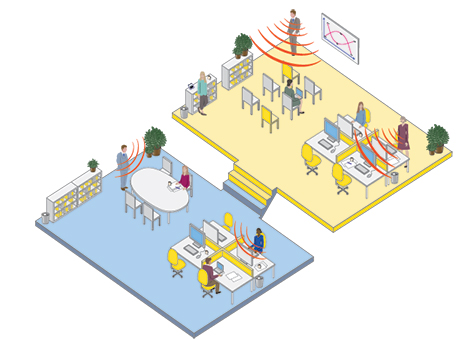
The acoustics in the work environment were measured several times throughout the study, following the guidelines in ISO 3382-3. In this way, the employees’ comfort distance was measured.
The study showed that people are strongly affected by
the sound environment in open plan offices. In terms
of comfort distance, there was a clear difference
in terms of speech spread:
The comfort distance was improved by 35% on the floor with better acoustics.
Perceived disturbance in general
The improved sound conditions also resulted in significant findings of reduction in perceived disturbance in general. The same pattern was observed on both floors.
The central bar (T2) shows the improved and the worsened sound conditions.
![]() = Floor 4
= Floor 4 ![]() = Floor 5
= Floor 5
Level of disturbance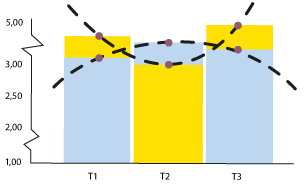 Test periods
Test periods
Perceived disturbance at close range
The study showed significant findings of reduction in disturbance at close range with the improved sound environment. The same pattern was observed on both floors, although to different degrees.
The central bar (T2) shows the improved and the worsened sound conditions.
![]() = Floor 4
= Floor 4 ![]() = Floor 5
= Floor 5
Level of disturbance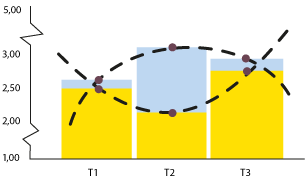 Test periods
Test periods
Perceived disturbance at long range
There was a significant reduction in disturbance at long range with the improved sound conditions.
The central bar (T2) shows the improved and the worsened sound conditions.
![]() = Floor 4
= Floor 4 ![]() = Floor 5
= Floor 5
Level of disturbance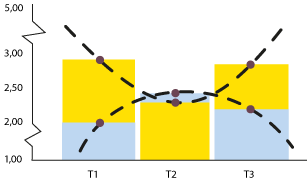 Test periods
Test periods
Perceived cognitive stress
The study also showed that the improved sound conditions lead to a significant reduction of cognitive stress.
The central bar (T2) shows the improved and the worsened sound conditions.
![]() = Floor 4
= Floor 4 ![]() = Floor 5
= Floor 5
Level of disturbance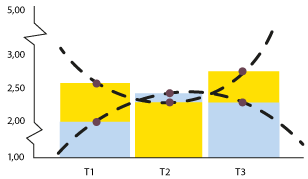 Test periods
Test periods
The Stress Research Institute is a national knowledge center focusing on stress reactions, sleep and health.
The Institute is part of the Faculty of Social Sciences at Stockholm University.
Read the full report
The study was conducted in collaboration with the Stress Research Institute in Stockholm under the leadership of Aram Seddigh, PhD, in Sundbyberg City Hall in the spring 2014. The study results were published in the Journal of Environmental Psychology in September 2015.
 *Dr Nigel Oseland is one of the world’s leading workplace consultants. His studies of psycoacoustics shows that psychological factors have a greater effect than the sound itself.
*Dr Nigel Oseland is one of the world’s leading workplace consultants. His studies of psycoacoustics shows that psychological factors have a greater effect than the sound itself.
For this reason, sound environments and the effects of changes made in a room must be studied in real office environments. Otherwise the study risks missing the factors that have the strongest effect.
